Society member, Chris Iwanicki recently sent me a message seeking assistance in identifying what he thought may have been two different angel shark species. Chris had been swimming about 100m out off of Somerton beach, in about 3m depth. He found what he thought may be two different specimens in the same location.
Here is his description of the discovery: –
“Hi Steve
I was wondering if you had any pictures of Ornate Angelsharks, Squatina australis, (for comparison) and could help positively identify these.
Yesterday, while trying out a new camera (OlympusTG-6), I came across what, at a distance, I thought was a shovelnose ray, except when getting closer, I found that it had a broad snout.
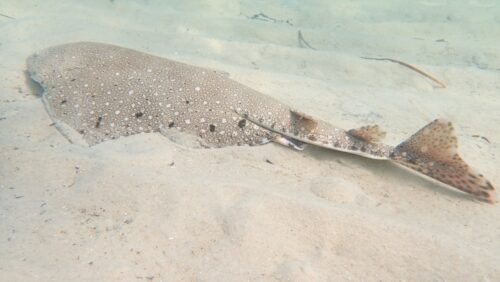
Looking closer, it had a mottled pattern and tendrils similar to a wobbygong.
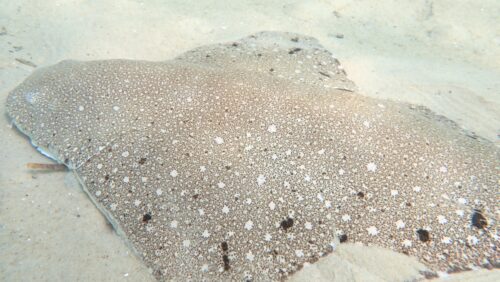
It seemed to have parked itself just behind an old imprint of a resting eagle ray. This new ray made a good subject for the camera as I had never seen anything like this, and it was, like many rays, content to ignore me moving about (by now cold and with no flippers or wetsuit. I had been in the water I think for about over 1.5 hours.)
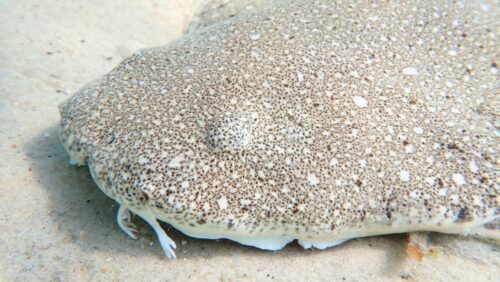
After about 5 minutes of taking both video and photos of the new mystery ray, including resting the camera in the depression left by the previous ray, I realized that the depression had a pair of eyes and there was a much bigger version of the ray that I was photographing.

By gently clearing some of the sand away from its left wing and front edge, I could see that it was much lighter in colour and almost twice the size of the one resting behind it. It looks like they are in the process of a courtship/mating. The smaller one is roughly estimated around 75cm.
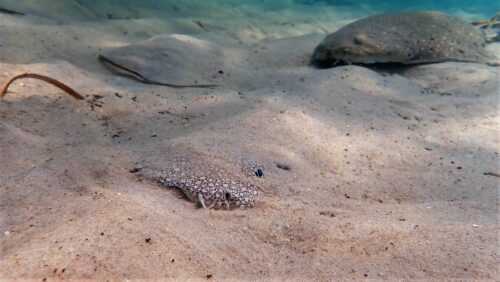
I later identified these as a pair of Angel sharks, Family Squatinidae (from the book “Sea Fishes of Southern Australia”) yet the smaller one is noticeably darker with darker markings.
Swainston’s “Fishes of Australia” illustrates the Ornate Angelshark, Squatina tergocellata, a deep-water species (which is described as being rarer).
To me the smaller Angelshark looks suspiciously like it might be an Ornate Angelshark (as pictured in Swainston’s) but I am not completely sure, and the larger one, being much lighter in colour, looks like an Angelshark (as according to “Sea Fishes of Southern Australia”).
The smaller one has dark spots, as shown clearly in the closer pictures.

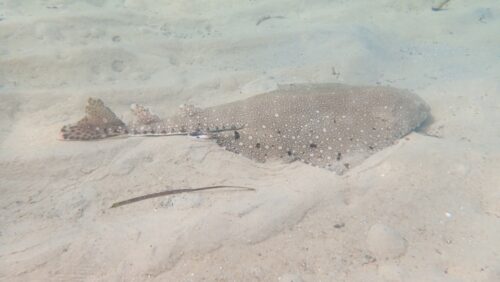
Feel free to share with other members, and yet another reason that I am against allowing spearfishing on the metro coast.”
My initial response to Chris was, “Congratulations, I’m jealous! I think that you have only seen Angelsharks, not the Ornate Angelshark. Ornates are a deep-water species – see Ornate angelshark – Wikipedia. I am sending you a page from my World Atlas of Marine Fishes which shows both species. ….. We can post your photos to iNaturalist for outside input.”
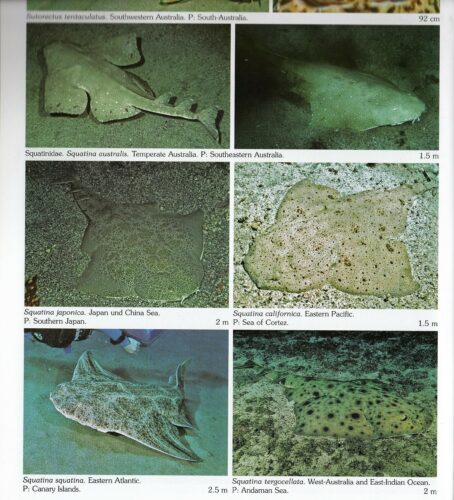
I followed this up with, “We don’t have any photos of our own. There has only been one recording from SA on iNat, a dead specimen in Yankalilla Bay in 2018.” Several messages followed, leading to this article.
Chris’ first message suggested, “If you see (this photo), and look on a decent computer screen, you can see the size difference between the two. The left wing of the larger is partially exposed showing the patterning and contrast in colour between the two.”: –
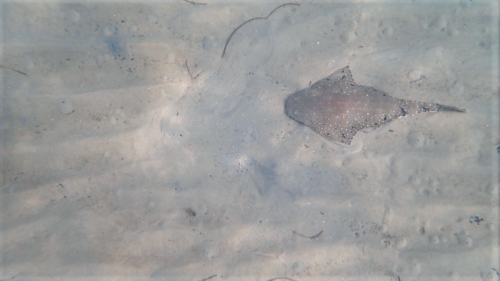
He also said, “(This photo) shows the position of the smaller shark over the larger from right side view.”: –

Then “(This is a) close up of the front of the larger buried shark.”: –

“(This photo shows the) left side view of the smaller shark.”: –

“(This photo shows the) right side close up of the head of the smaller showing the eye, tendrils, and patterning.”: –

(This photo shows the) top left side view showing patterning being larger white blotches, smaller darker and dark blotches on back.”: –

This is the smaller of the two specimens on the same spot.”
(This is all possibly another example of Fish Behaviour Observed During Autumn .)
At some stage, Chris asked, “Do you know if, like with many species, they have set locations for mating etc?” I continued to research Angel Sharks, mostly via my library of fish reference books. I would report each finding back to Chris. According to Marine & Freshwater Fishes of South Australia for example, the colour of the Angel Shark is somewhat variable, depending on the type of bottom, with which the colour harmonizes. Also, viviparous* and breeding during Autumn months (NOW).
* (Later said to be Ovoviviparous (aplacental viviparity) – produce young by means of eggs which are hatched within the body of the parent.)
Further, “Major differences between the shallow water species and the deep water Ornate Angel Shark:
Ornate is smaller, about 1/3 size
Ornate is yellowish-brown above, has small blue spots and large brown rings
Angel shark is sandy, with white spots and grey dots
Ornate has dorsal denticles of the body bearing 3 keels
Angel Shark denticles have no keels”
David Muirhead also had some input, as follows: –
“Both species found here are said to be common, based mainly on trawl data, with each species apparently marketed in small numbers.
But not necessarily common (if even known to venture into waters as shallow as yours!…but I’m going on limited info from the old 2008 bible); Angelsharks are found from minimum depth of 15m out to 230m according to Gomon, Bray & Kuiter’s “Fishes of Australia’s Southern Coast” (2008), and for Ornates, that book says 130-400m) .
I’ve never seen one, let alone got photos of any, so I’m envious.
Going on the excellent descriptions of the 2 species in that book, I’m sure both your angelsharks are Squatina australis, i.e. not Ornates (Squatina tergocellata).
The overall dark vs light colour difference is too subtle to use as an ID tool, and anyway all demersal rays and sharks vary in that respect within a species, due factors such as age, base colour of the benthic habitat from site to site and day to day (?also maybe season, maybe gender, etc..)
Ornates (in that book…old, I know) don’t reach into Gulf St Vincent, only the far west of SA, with main distribution in the south-west of WA.
While neither ‘should’ occur in less than 15m, yours are not much shallower than that.
Whereas if one was an Ornate it’d be VERY unusual (unless sick or dying after a major storm or discarded still alive by a trawler returning to port, or etc..) to find one in the shallows.
And neither of yours have the prominent dark brown ocelli of Ornates.
Both species have lots of spots and flecks, mostly white to grey but the photos in the above book also show some biggish black flecks and biggish white to light grey/brown flecks that could almost be considered as ocelli but only the Ornate has unequivocal (indeed very striking) ocelli.
Definitely both yours are S. australis.
Possibly they come inshore to reproduce?? (I’m only guessing now).
Both species attain similar sizes (1.52m max TL and 1.4m max TL respectively) so that’s no help.
But when all’s said and done, you’ve captured what I think is a rare thing; good quality underwater images of 2 Angelsharks (S. australis).
I suggest you ask Steve to liaise with you by putting your pics and your prose (edited slightly if you wish, but ‘as is’ would suffice…whatever you tell Steve he’ll do, exactly) up as a MLSSA feature article.
Finally, as you don’t do iNaturalist (as I recall?), I’d love you to join iNat so these photos can be seen by the real experts on that site.
Or, if you prefer, I may be able to submit them to iNat, credited to you [i.e. NOT TAKEN BY ME, taken by fellow MLSSA member Chris Iwanicki], but Steve’s better at doing those things too (I’ll struggle to ‘cut and paste’ your pics onto iNat; I’d eventually manage but would take me much longer!!)
Congrats, Dave M”
(By this time, I had posted Chris’ photos to iNat at https://www.inaturalist.org/observations/110356134 . At this stage, one regular contributor (expert/identifier) has ID’d the photos as being of the Australian Angelshark, Squatina australis.)
David Muirhead later went on to say, “Breeding in autumn is an important factor. Fairly safe bet that your 2 were a breeding pair (or, much less likely, territorial stand-off/mating fight between 2 of same gender but different sizes), which makes your photos and observations on the two even more important (perhaps never witnessed before?).
I sent Chris a links to some video footage showing that Angel Sharks are “Not so harmless!”: –
https://www.bing.com/videos/search?q=angel+shark+attack&qpvt=angel+shark+attack&FORM=VDRE
And links to some more video footage showing that you should not harass or annoy an angel shark, and do not grab their tail: –
https://www.bing.com/videos/search?q=angel+shark+attack&&view=detail&mid=2A1C565F3326AF869A202A1C565F3326AF869A20&&FORM=VDRVSR or https://www.bing.com/videos/search?q=angelsharks&docid=608045336490875063&mid=2A1C565F3326AF869A202A1C565F3326AF869A20&view=detail&FORM=VIRE
Chris sent his photos in to the SA Museum and received the following response from them: –
“Dear Chris
Thank you for your enquiry. Some nice photos!
This is Squatina australiis, not a S. tergocellata. The collective reason for this identification is: –
1) interocular space flat or convex;
2) lacking prominent ridges and denticles above eyes
3) prominent pairs of dark brown “mitotic” ocelli lacking.
Hoping that clarifies things for you.
Would be good to put this record up on iNaturalist, if you haven’t already.
Yours sincerely
James Smith (Mon/Wed/Fri)
Information Officer, Discovery Centre
South Australian Museum”

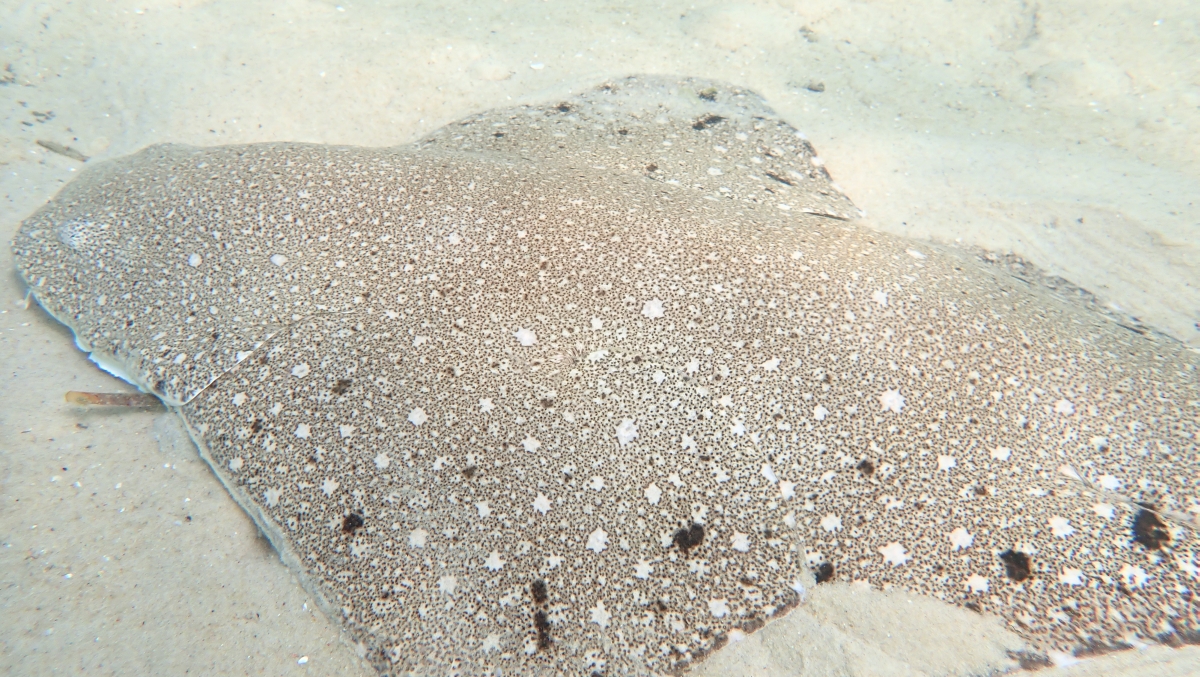
For me the most tantalising aspect of this topic is that the finding of 2 adults in only a few metres depth suggests that the species comes into very shallow gulf waters to breed.
Especially as that hypothesis seems to have arisen( very belatedly in terms of what we should know about less commercial species but very often don’t) from within the realm of citizen science.
Chris’s observations while snorkeling only a few weeks ago seem to be the first hint that the species comes inshore to breed! ( disclaimer:-I have not researched the topic so I may be out of line entirely)
If Angelsharks S.squatina really do enter shallow subtidal sandy areas each autumn to reproduce, they would be following the example of the Rock Ling (G.tigerinus),and presumably some other southern Australian endemics.
In the case of the Rock Ling that aspect of it’s life history is generally regarded as an important factor in the decline in its populations over the last century or so .
When the large adults are present inshore they are sitting ducks for spearos and, in the past, nets set commercially and recreationally caught many when they were at their most vulnerable.